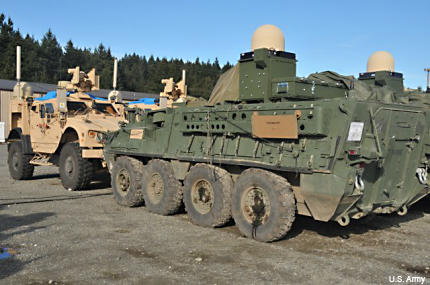Army bringing Strykers into its tactical battlefield network
Service adds another unit to the satellite-based WIN-T, which reduces reliance on fixed for line-of-sight communications.

The Army’s fleet of Stryker combat vehicle is fast, mobile and versatile, able to reach speeds of more than 60 mph, navigate difficult terrain and, in its various configurations, do everything from carrying troops to performing reconnaissance to, of course, operating as a mobile gun platform. Now, they’ll be able to communicate better, too.
The Army is beginning to incorporate Strykers into its tactical battlefield network, Warfighter Network Information-Tactical, or WIN-T, most recently with vehicles in the 2nd Stryker Brigade Combat Team at Joint Base Lewis-McChord, Wash. The Strykers being retrofitted will get WIN-T Increment 2 satellite capabilities, along with the GPS-based Blue Force Tracking system used in joint operations.
WIN-T Increment 2, which operates at the brigade, battalion and company levels, delivers voice, video and data communications over greater distances to forces in the field. Blue Force Tracking provides locations information on friendly and opposing forces. The setup includes the Army’s latest communications system, Capability Set 15, which reduces reliance on fixed and line-of-sight communications, the Army said.
"These capabilities give commanders a huge advantage in knowing what is happening on the battlefield," Capt. Minou Pak, signal company commander for the brigade combat team, said in an Army release. "It is a much more redundant system, which we can use to react quicker and maneuver through the battlefield much faster and more efficiently."
The Army has long been working to extend its network to the front lines, a plan that is the driving force behind WIN-T. Increment 2 takes the network to the company level. Work on Increment 3 is focusing on simplifying the network, because all those added nodes increase complexity. Although that work has been slowed somewhat by budget constraints, the ultimate goal is to expend communications—and the operational picture—to the squad level or even individual soldiers.
NEXT STORY: Navy’s S&T strategy: Lean on technology




